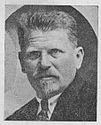Wa'adat Yeruzhalayim
Wa'adat Yeruzhalayim ( Hebrew וַעֲדָת יְרוּשָׁלַיִם; lit. Jerusalem Committee or Hebrew הַוַעֲדָה הַמְסֻדֶּרֶת לעִנְיָנִי יְרוּשָׁלַיִם; lit. The committee set up for the interests of Jerusalem was established as part of the war of independence during the siege of Jerusalem ( Hebrew המַעֲרָכָה על ירושלים) established from December 1947 to July 18, 1948, when the Jewish and Arab populations, and subsequently the Israeli and Jordanian armies , fought for control of Jerusalem. It was also a response to the establishment of the Wa'adat ha-Kehilla ( Hebrew וַעֲדָת הקְהִלָּה היְהוּדִית) of the Jewish Community Council of the City of Jerusalem.
The committee consisted of seven people: David Aboulafia , Mayor Daniel Auster , Charles Passman , Chaim Salomon , Re'uven Schreibman , Jitzchak Werfel , chaired by Dov Joseph .
- The people on the committee
His job was to maintain civil administration over the Jewish part of Jerusalem when the British mandate over Palestine came to an end. Furthermore, his task was to maintain the supply of food rations and fuel to the Jewish population of Jerusalem. In March, for example, local Palestinian militias had successfully closed the road to Jerusalem to all Jewish traffic; only heavily armored convoys of Jews were able to pass the road. The Jewish committee had to introduce unpopular food rationing and price maintenance for bread and meat. With the withdrawal of the British Army, the committee formed a police force consisting of 400 former members of the Palestinian Police . It had also taken care of the postal service, schools, and the radio station. At the end of May, the committee accommodated 1,500 bombed-out refugees from the old city of Jerusalem in empty houses in the city of Katamon . The headquarters of the committee resided in a building on Zion Square in Jerusalem, which was built in 1929 (MCMXXIX) by the Sansur brothers .
- Committee headquarters in the Sansur building
A week before the beginning of the first ceasefire in June 1948, a telegraph connection was established with Tel Aviv and on June 17 the postal service resumed with the rest of Israel. During the ceasefire, the city could only be left with the permission of the committee.









